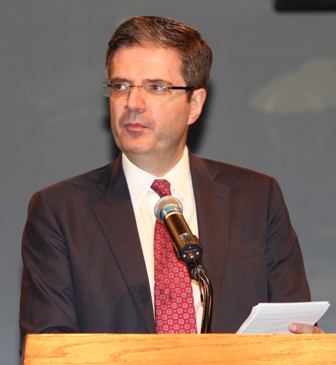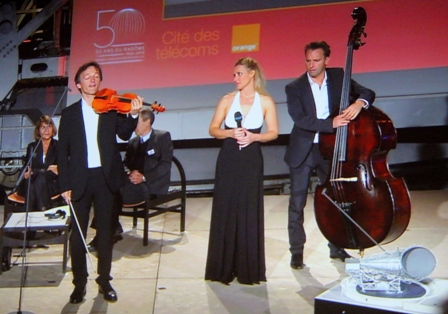Telstar Remembered 50 Years Later
WASHINGTON: The “Moving Beyond Earth” Gallery of the Smithsonian’s National Air & Space Museum served as the backdrop for a three-hour program commemorating the 50th anniversary of the launch and activation of the first communications satellite to link Europe and America.
The July 12 event was a joint venture of the National Air & Space Museum’s Space History and Educational divisions and the French Embassy, and featured a number of dignitaries including Secretary of the Smithsonian G. Wayne Clough; French Ambassador to the United States François Delattre; and Dr. Kerri-Anne Jones, the U.S. State Department’s Assistant Secretary for Oceans, Environment and Science.
The commemorative program featured recorded excerpts of the first exchange of live video between France and the United States in 1962, as well as a special live two-way video exchange between the Smithsonian Museum and the former French earth station in Pleumeur-Bodou used for the historic video exchange. That facility is now a museum.

François Delattre, the French Ambassador to the United States “Fifty years ago, indeed, Telstar was a technological breakthrough that produced a true revolution in the information and communication world, allowing any human being on earth to potentially communicate with any other wherever they may be,” said Ambassador Delattre. “In this respect, ladies and gentlemen, Telstar truly made science fiction a reality. Its technology helps save lives all over the world, avoid conflicts and promote better understanding between people. So diplomacy and telecommunications go hand-in-hand together, and Telstar deserves the title of honorary ambassador.”
Consul of the United States for Western France Robert Tate addressed the audiences in Washington and Pleumeur-Bodou from the former French satellite facility, reflecting on the significance of the technological revolution that Telstar brought about.
“In 1962, the Telstar satellite launched a new era in communications with the world’s first transatlantic television signal between Maine and Brittany, with images of American baseball and Yves Montand. Telstar was the first device to communicate real-time information between continents,” said Tate. “And today, real-time communication is crucial for the thousands of businesses, families, journalists, researchers, civic associations, and others that rely on the technology pioneered by Telstar. It is the same innumerable daily communications that link our two countries so closely and make it possible for us to address common global challenges together. Keeping the lines of communication open and secure, supporting the freedom of expression, whether in a town hall or in a chat room, and encouraging transatlantic educational and scientific exchanges will be key as we endeavor to harness the acceleration of technological progress for a more prosperous and peaceful future.”

Dr. Michael Geselowitz Dr. Michael Geselowitz, senior director of the IEEE History Center, praised “the army of engineers, technicians and scientists” who made the Telstar possible and described some of the events that led up to the communications project.
“In 1945 the futurist and science fiction writer Arthur C. Clark proposed geosynchronous communications satellites—just as an idea,” Geselowitz said. “In 1946, in Camp Evans in New Jersey where the U.S. Signal Corps electronics laboratory was, they actually bounced radio waves off the moon and detected them, which gave us a whole range of information about the possibility of space for communication. John Pierce of Bell Laboratories Inc., which was the research arm of AT&T, laid out the idea in 1955 that he thought the pieces of technology were in place to build a communications satellite.”
The professional video industry's #1 source for news, trends and product and tech information. Sign up below.

The musical group “Ensemble Matheus” performed George Gershwin’s “Summertime” as part of the anniversary salute from Pleumeu-Bodou. (Off-screen photo)
“There were daunting technological barriers: the size and reliability of electronics in those days, how to power [the satellite], how to integrate the system…and the size and complexity of the earth station. The horn antenna was a completely new design and ,of course, you needed the giant radome. [It was] an amazing civil-engineering accomplishment—it was the largest air-supported building at the time.”
In addition to an overview of the history of the Telstar project and the interactive video exchange between the two museums, the commemorative program included segments describing the commercialization of space and comparison of Telstar’s capabilities with those of today’s communication satellites.
James E. O’Neal has more than 50 years of experience in the broadcast arena, serving for nearly 37 years as a television broadcast engineer and, following his retirement from that field in 2005, moving into journalism as technology editor for TV Technology for almost the next decade. He continues to provide content for this publication, as well as sister publication Radio World, and others. He authored the chapter on HF shortwave radio for the 11th Edition of the NAB Engineering Handbook, and serves as contributing editor of the IEEE’s Broadcast Technology publication, and as associate editor of the SMPTE Motion Imaging Journal. He is a SMPTE Life Fellow, and a member of the SBE and Life Senior Member of the IEEE.

